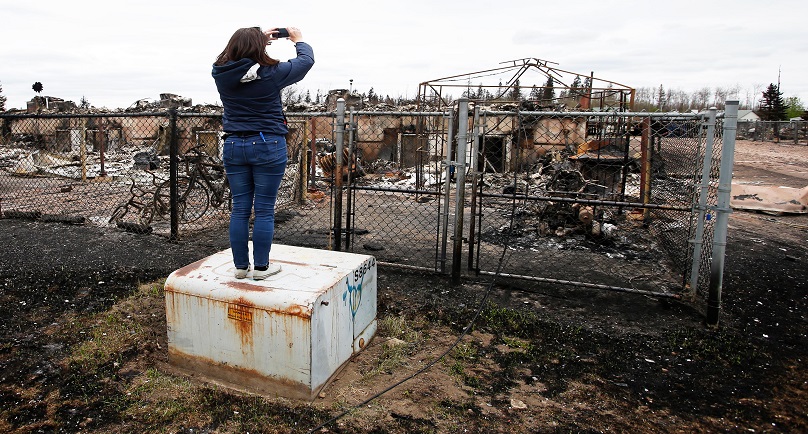Image: A woman takes photos of the burned remains of a house in the Abasand neighbourhood of Fort McMurray, Alberta, Canada, May 9, 2016 after wildfires forced the evacuation of the town. REUTERS/Chris Wattie
![]()
By Liz Hampton and Nia Williams
EDMONTON, Alberta (Reuters) – Oil sands companies around the Canadian energy center of Fort McMurray began to restart operations on Tuesday after an out-of-control wildfire forced a week-long shutdown.
Top provincial and industry officials said production in much of the region should ramp up soon. Facilities north of Fort McMurray that had been shuttered largely because of heavy smoke rather than fire were seen as likely to come back on line in a matter of days in many cases.
While the fire continued to grow on Tuesday, officials said it was moving to the south and east, away from the area’s largest oil production facilities and into sparsely populated areas. A handful of smaller facilities remained under fire threat, however, and some could not yet be reached for damage assessments.
Royal Dutch Shell Plc became the first company to resume its operation in the center of Canada’s oil sands region. Enbridge Inc began inspecting its facilities and prepared to restart operations shuttered during the blaze.
“While thousands of lives will never be the same, we can take small steps to getting back the rhythm of northeast Alberta,” Alberta Premier Rachel Notley told reporters after meeting with executives from companies including Suncor Energy Inc, ConocoPhillips Canada and the Canadian Association of Petroleum Producers.
“For many in Fort McMurray, that means rolling up the sleeves, and returning to work doing what they love, which is working in the energy sector,” she said in Edmonton.
Steve Williams, chief executive of Suncor, said the industry has plenty of housing available at project sites north of the city. Despite last week’s mass evacuation, gathering a sufficient workforce would not be a barrier to restarting operations.
“We have a huge capability for moving significant numbers of people,” Williams said at the press conference. “In that sort of 48-72 hour period immediately following the evacuation … we were able to evacuate significantly more than 20,000 people.”
The meeting came a day after Notley led an inspection tour of Fort McMurray, which found that the town was less damaged than initially feared with about 90 percent of its buildings surviving the blaze.
But its 88,000 residents, who last week were hurriedly evacuated as far away as the provincial capital Edmonton, 380 km (235 miles) to the south, will not be able to return to their homes for weeks.
Energy industry officials have been grappling with transportation problems for staff because the specialists who run the oil production sites were also among the residents displaced by the blaze.
Shell said it will fly staff in and out of the region, while Imperial Oil Ltd said its Kearl oil sands mining project will remain shut until the company worked out the logistics of moving people and materials to and from the remote site.
But Notley said some movement of goods and materials by road through Fort McMurray had resumed earlier on Tuesday.
Syncrude restarted power generation at its oil sands mine in Aurora, about 80 km (50 miles) north of Fort McMurray, as it began planning to resume operations, a spokeswoman said.
TOWN STILL SMOLDERING
The blaze grew moderately on Tuesday to 229,000 hectares (560,000 acres) and spread east through terrain with no communities. It merged with another fire burning near Campbell Lake, some 50 km (30 miles) east of Fort McMurray.
One area remaining under threat was Hangingstone, about 60 km (36 miles) south of Fort McMurray, and home to at least two smaller facilities run by Athabasca Oil Co. and Japan Canada Oil Sands Ltd. Both are shut, but between them account for only about 17,000 barrels per day of output, a fraction of the roughly 1 million barrels a day that has been lost to the fire, half of Canada’s daily production.
Notley said she believed facilities at Hangingstone were intact, but the area was not yet accessible due to the fire threat.
The largest-producing oil projects in the Fort McMurray area are about 20 km (12 miles) north of the town and not in the fire’s current path. Suncor’s Williams said those facilities had not incurred damage and were closed due to smoke, not fire.
He said Suncor would not suffer any material losses from the blaze.
The inspection of Fort McMurray revealed blocks of homes reduced to blackened foundations, front steps and metal barbecues. Notley said 2,400 structures had burned within the city while almost 25,000 were saved.
Officials warned it was not safe for residents to return to the town, with parts still smoldering and large areas without power, water and gas. Notley said repair crews will need weeks to make the city safe.
Prime Minister Justin Trudeau told the House of Commons he would go to Fort McMurray on Friday. Canada’s labor minister told reporters on Tuesday that the federal government would ensure that people put out of work by the blaze receive unemployment payments.
Canadian crude prices slipped on Tuesday, trading below the U.S. crude benchmark, as signs of resuming production eased supply concerns.
Nearly all of Fort McMurray’s residents escaped the fire safely, although two teenagers died in a car crash during the evacuation.
(Additional reporting by Rod Nickel in Lac La Biche; Ethan Lou and Allison Martell in Toronto; and David Ljunggren in Ottawa; Writing by Dan Burns and Scott Malone; Editing by Jeffrey Benkoe and Cynthia Osterman)
Copyright 2016 Thomson Reuters. Click for Restrictions.


